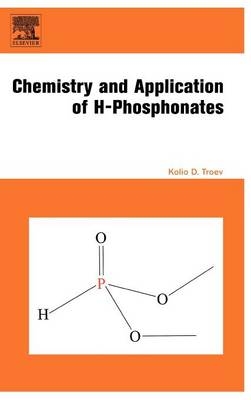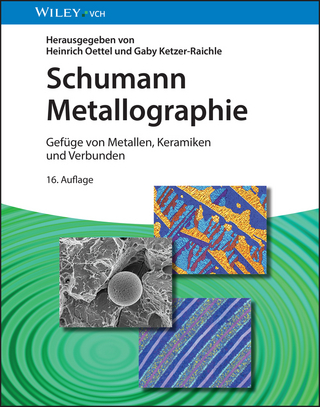
Chemistry and Application of H-Phosphonates
Elsevier Science Ltd (Verlag)
978-0-444-52737-0 (ISBN)
- Titel ist leider vergriffen;
keine Neuauflage - Artikel merken
Chemistry and Application of H-Phosphonates is an excellent source for those planning the synthesis of new phosphorus-containing compounds and in particular derivatives containing a phosphonate, phosphoramide or phosphonic acid diester group. The rich chemistry, low cost and easy availability of diesters of H-phosphonic acid makes them an excellent choice as synthone in a number of practically important reactions. Phosphonic acid esters are intermediates in the synthesis of important classes of compounds such as alpha-aminophosphonic acids, bisphosphonates, epoxyalkylphosphonates, alpha-hydroxyalkylphosphonates, phosphoramides, poly(alkylene H-phosphonate)s, poly(alkylene phosphate)s, nucleoside H-phosphonates. The synthesis of each of these compound classes is reviewed in detail. Alpha-Aminophosphonic acids are an important class of biologically active compounds, which have received an increasing amount of attention because they are considered to be structural analogues of the corresponding Alpha-amino acids. The utilities of alpha-aminophosphonates as peptide mimics, haptens of catalytic antibodies, enzyme inhibitors, inhibitors of cancers, tumours, viruses, antibiotics and pharmacologic agents are well documented. Alpha-Hydroxyalkanephosphonates are compounds of significant biological and medicinal applications. Dialkyl epoxyalkylphosphonates are of interest because of their use as intermediates in the synthesis of bioactive substances, and as modifiers of natural and synthetic polymers. Bisphosphonates are drugs that have been widely used in different bone diseases, and have recently been used successfully against many parasites. Poly(alkylene H-phosphonate)s and poly(alkylene phosphate)s are promising, biodegradable, water soluble, new polymer-carriers of drugs. Nucleoside H-phosphonates seem to be the most attractive candidates as starting materials in the chemical synthesis of DNA and RNA fragments. The 5’-hydrogen phosphonate-3’-azido-2’,3’-dideoxythimidine is one of the most significant anti-HIV prodrug, which is currently in clinical trials. Chapters review the synthesis; physical and spectral properties (1H, 13C, 31P and 17O NMR data); characteristic reactions; important classes of compounds based on these esters of H-phosphonic acid; their application as physiologically active substances, flame retardants, catalysts, heat and light stabilizers, lubricants, scale inhibitors, polymer-carriers of drugs; preparation of H-phosphonate diesters and general procedures for conducting the most important reactions.
Kolio Dimov Troev completed his undergraduate work at Higher Institute of Chemical Technology, Sofia; received his doctorate in the field of organophosphorus chemistry in 1974 from the Institute of Organic Chemistry, Bulgarian Academy of Sciences with Prof. Georgy Borissov; and was awarded the scientific degree “Doctor of Science in 1985 from the Institute of Polymers. In 1988, he became Professor of Chemistry at the same Institute. He has been the founding head of the laboratory “Phosphorus-containing monomers and polymers since 1989. His research interests are the areas of organophosphorus chemistry, especially esters of H-phosphonic acid; aminophosphonates; biodegradable, biocompatible phosphorus-containing polymers; polymer conjugates; drug delivery systems. He has been a visiting professor/lecturer in the USA (Marquette University, Tulane University), Japan (Tokyo Institute of Technology, University of Tokyo, Tohoku University, Tokyo University of Science), and Germany (Duesseldorf University). He is the author of more than 150 papers in this field published in the Phosphorus, Sulfur, Silicon and Related Elements, Heteroatom Chemistry, Journal of American Chemical Society, European Polymer Journal, Polymer, Bioorganic & Medicinal Chemistry, Journal of Medicinal Chemistry, Macromolecular Rapid Communication, Polymer Degradation and Stability, Journal of Polymer Science, Part A: Polymer Chemistry, European Journal of Medicinal Chemistry, Amino Acids, Tetrahedron Letters, Macromolecules, and RSC Advances. He is also the author of two other Elsevier books, Chemistry and Application of H-phosphonates (2006) and Polyphosphoesters: Chemistry and Application (2012). He was a director of the Institute of Polymers, Bulgarian Academy of Sciences from November 2003 to February 2012.
Chapter 1. Methods for preparation and physical properties of H-phosphonates 1.1. From phosphorus trichloride and alcohols 1.2. From H-phosphonic acid 1.3. From white phosphorus and alcohols 1.4. Others 1.5. Physical properties 1.6. Thermal stabilityChapter 2. Structure and spectral characteristics of H-phosphonates 2.1. Electronic structure of phosphorus atom2.2. Nature of the chemical bonds in phosphoryl group2.3. Molecular structure of dimethyl H-phosphonate 2.4. Tautomerization of dialkyl H-phosphonates 2.5. Spectral characteristics Chapter 3. Reactivity of H-phosphonates3.1. Acidity of H-phosphonate diesters 3.2. Disproportionation 3.3. Reduction3.4. Hydrolysis 3.5. Acidolysis 3.6. Substitution reactions at the phosphorus atom Chapter 4. Important classes of compounds 4.1. Aminophosphonic acids 4.2. Bisphosphonates 4.3. Nucleoside H-phosphonates4.4. Epoxyalkylphosphonates 4.5. Poly(alkylene H-phosphonate)s 4.6. Metal salts of dialkyl H-phosphonates 4.7. Complexes of dialkyl H-phosphonates Chapter 5. Application of H–phosphonates and their derivatives5.1. Physiologically-active substances5.2. Polymer additives5.3. Degrading and alkylating agents of polymers 5.4. Heat, light and UV stabilizers 5.5. Catalysts 5.6. Corrosion inhibitors 5.7. Scale inhibitors 5.8. Lubricants
| Erscheint lt. Verlag | 19.7.2006 |
|---|---|
| Verlagsort | Oxford |
| Sprache | englisch |
| Maße | 165 x 240 mm |
| Gewicht | 690 g |
| Themenwelt | Naturwissenschaften ► Chemie |
| ISBN-10 | 0-444-52737-0 / 0444527370 |
| ISBN-13 | 978-0-444-52737-0 / 9780444527370 |
| Zustand | Neuware |
| Informationen gemäß Produktsicherheitsverordnung (GPSR) | |
| Haben Sie eine Frage zum Produkt? |
aus dem Bereich


